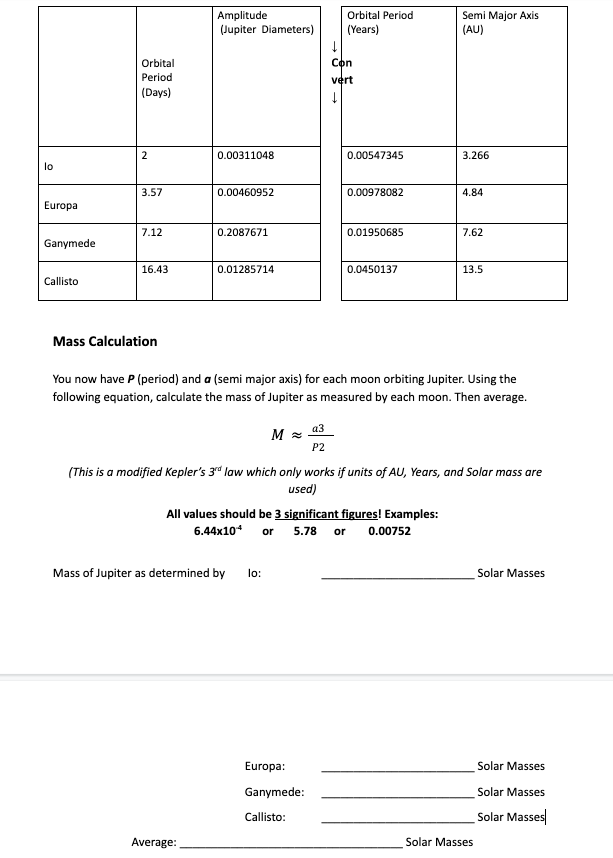lo Europa Ganymede Callisto Orbital Period (Days) 2 3.57 7.12 16.43 Amplitude (Jupiter Diameters) 0.00311048 0.00460952 0.2087671 Average: 0.01285714 Mass of Jupiter as determined by M lo: Orbital Period (Years) a3 P2 ↓ Con Europa: Ganymede: Callisto: vert ↓ 0.00547345 0.00978082 0.01950685 All values should be 3 significant figures! Examples: 6.44x104 or 5.78 or 0.00752 0.0450137 Mass Calculation You now have P (period) and a (semi major axis) for each moon orbiting Jupiter. Using the following equation, calculate the mass of Jupiter as measured by each moon. Then average. Semi Major Axis (AU) 3.266 (This is a modified Kepler's 3rd law which only works if units of AU, Years, and Solar mass are used) 4.84 7.62 13.5 Solar Masses Solar Masses Solar Masses Solar Masses Solar Masses
lo Europa Ganymede Callisto Orbital Period (Days) 2 3.57 7.12 16.43 Amplitude (Jupiter Diameters) 0.00311048 0.00460952 0.2087671 Average: 0.01285714 Mass of Jupiter as determined by M lo: Orbital Period (Years) a3 P2 ↓ Con Europa: Ganymede: Callisto: vert ↓ 0.00547345 0.00978082 0.01950685 All values should be 3 significant figures! Examples: 6.44x104 or 5.78 or 0.00752 0.0450137 Mass Calculation You now have P (period) and a (semi major axis) for each moon orbiting Jupiter. Using the following equation, calculate the mass of Jupiter as measured by each moon. Then average. Semi Major Axis (AU) 3.266 (This is a modified Kepler's 3rd law which only works if units of AU, Years, and Solar mass are used) 4.84 7.62 13.5 Solar Masses Solar Masses Solar Masses Solar Masses Solar Masses
Related questions
Question

Transcribed Image Text:lo
Europa
Ganymede
Callisto
Orbital
Period
(Days)
2
3.57
7.12
16.43
Mass Calculation
Amplitude
(Jupiter Diameters)
0.00311048
0.00460952
0.2087671
Average:
0.01285714
Mass of Jupiter as determined by
Orbital Period
(Years)
a3
P2
lo:
Con
vert
↓
Europa:
Ganymede:
Callisto:
0.00547345
0.00978082
0.01950685
All values should be 3 significant figures! Examples:
6.44x104 or 5.78 or 0.00752
0.0450137
You now have P (period) and a (semi major axis) for each moon orbiting Jupiter. Using the
following equation, calculate the mass of Jupiter as measured by each moon. Then average.
M≈
Semi Major Axis
(AU)
3.266
(This is a modified Kepler's 3rd law which only works if units of AU, Years, and Solar mass are
used)
4.84
7.62
13.5
Solar Masses
Solar Masses
Solar Masses
Solar Masses
Solar Masses

Transcribed Image Text:4. Using your result from the previous question, determine how much more massive
Jupiter is compared to Earth (fractional, i.e. Jupiter is X times more massive than Earth).
Show your work!
Expert Solution
This question has been solved!
Explore an expertly crafted, step-by-step solution for a thorough understanding of key concepts.
This is a popular solution!
Trending now
This is a popular solution!
Step by step
Solved in 2 steps
